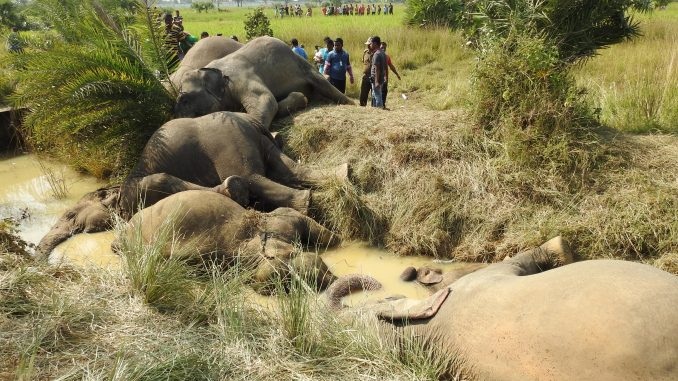Keonjhar: Shrinking of forest covers in Keonjhar, Dhenkanal, Angul, Jajpur, Sundargarh and Deogarh districts have led to drastic loss of habitat for elephants. Causalities of the animals in these districts have not yet stopped, despite preventive measures.
According to sources, Keonjhar district alone has reported 42 elephant death cases over past one decade. Environmentalists have expressed their deep concern over casualties as no project for elephants and their corridors’ protection has been executed.
Elephant corridors are damaged for various reasons; animals often head towards human settlements and cause mayhem. Petrol pumps located on NH-24, 49 and long queues of mineral-laden heavy vehicles parked on national highways of Keonjhar district have allegedly resulted in untoward incidents, elephant experts opined.
Environmentalist Bimbadhar Behera has expressed his deep concern saying, “Despite prolonged demand for construction of underpass at some locations on these national highways for easy movement of pachyderms, the state government has shown an apathetic attitude.”
On being contacted, Ghatagaon forest range officer Ashok Nayak said, “Although there is an underpass on the national highway for wild animals, a petrol pump at a few yards away is allegedly causing hindrance in free movement of pachyderms, while crossing roads.”
Worthy to note, a vast forest area of 10,000 hectares in aforesaid four districts was earmarked for ambitious Baitarani Elephant Conservation Project about 20 years ago, for safety of elephants. A number of seminars and workshops were held to take public opinion about the project in those districts. But, the project got stuck in red tapes.
Likewise, an elephant corridor project was also pushed into cold store. It is said that lakhs of rupees was initially spent on identifying a vast area for elephant corridor comprising Karo-Karmapada under Barbil range and Karadangi-Kakudia under Telkoi range in the Keonjhar district.
However, much before approval of this project, the state government permitted mining of iron and limestone from the same area. There are over 100 elephants in Keonjhar forest division alone, with 40 of them in Telkoi range. The proposed elephant corridor was planned for a 32-km stretch— from Karadangi to Kakudia area in this district.
Wildlife lovers and environmentalists have voiced their concern over safety of elephants which have been facing threat of habitat loss, non-availability of food, water and many other factors. They have pointed out that the elephants should have adequate fodder inside forests.
Unavailability of safe corridors to pass through gives rise to the perennial issue of human-animal conflict. Horrifying deaths of the elephants which occurred in Odisha have sparked debates that the state can no longer neglect its wildlife corridors, experts suggested.
In the absence of safe corridors to pass, elephants usually enter into human settlements; raid crops, devastate houses and get mobbed or at times electrocuted, as the case may be on different occasions.
The state government should declare all its elephant corridors as protected zones and stop ongoing developmental activities there, experts opined. If some of the developmental activities cannot be barred at all, then appropriate planning should be made involving the conservationists who have been studying on and trying to conserve such corridors, they added.
Moreover, several mitigation measures should be developed such as underpasses, overpasses, check gates and bridges. Those measures may be incorporated into a development plan, the experts advised.
Notably, Odisha was the state in past which boasted of having the country’s highest number of elephants. The state government’s gross inactions coupled with manmade disasters like poaching, electrocution and trapping have rendered it a deadly graveyard for the pachyderms.
PNN
